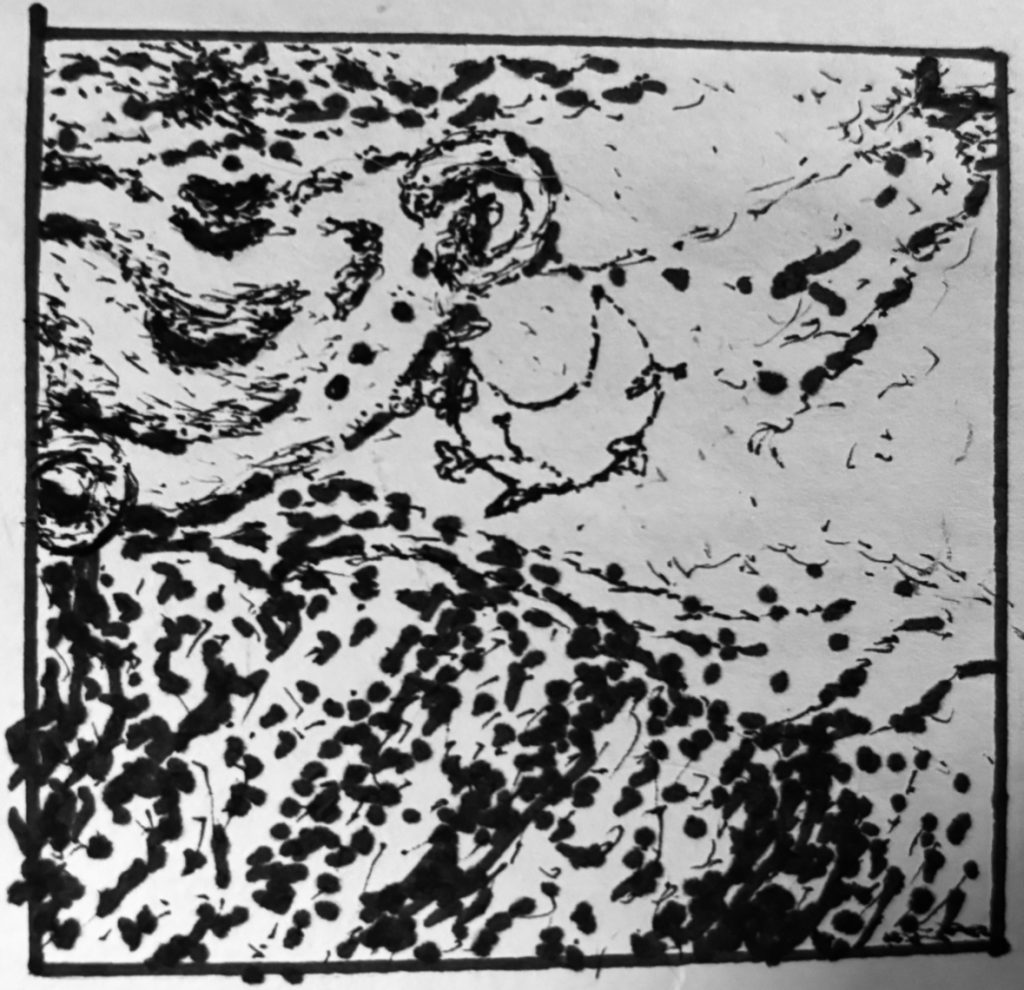Zebra Stripes Mark Out My Life
zebra skips over river and crocodile jumps
and takes a bite out of his belly underside.
zebra kicks croc away
and lands on other side of clough ravine of river.
his cherry-blossom innards ribboning out in mountains.
he kicks instinctually, hoofing around.
and kicks out entrails on loop.
gunshot wound to the head, explodes one-half of cranium.
and it slops away like melted ice cream,
with small pork chops in the whipped cream
dropping, cow-milked, to the bare ankles
and staining them with fresh blood hues.
unlike that, entrails remain in a cohesive snake.
the zebra’s fluctuating between albino boiled chicken
and red as red as red.
the straight highway that runs from top to bottom.
the croc was ad-lib but will eat up the ugly business.
zebra stands still, glib, as the meat is torn away.
there is no embarrassment outside of man.
even if this was Take The Piss Thursday and W. C. Fields
used his day in charge from beyond the grave
to orchestrate the zebra’s demise.
we were all meant to laugh I guess.
And I can hear him still cackling from heaven.
drought has burned up the river
and equally it makes the innards taste defective
and the croc surfaces to spit them up.
and they float on the surface like red bits of cogs.
the croc stays up feigning slapstick vomitous disgust.
W. C. on vermouth, makes another play at a masterstroke.
sickly ICU lights in San Tropez.
was problematical when I tried to murder my stepfather and he survived.
I used an undergrad’s computer to fake my alibi
and was disheartened when they pumped the blood back into him
like there was no tomorrow and like there was no limit to
the blood in the world.
zebra at last falls dead
and the innards just lie there. no one wants them.
except Alistair Cowley who takes them in
a handbag of alligator leather
and keeps his bare feet away from the lurching croc.
he’s ill in the head but good at train hopping.
witches made good use of entrails on a constant basis.
they plied them with frog’s legs
and brandy spilling down their hinges
and maybe some of that vermouth, Mr W. C.
and maybe some of that sweat beer-knifed off your skinhead
Mr Cowley.
And oh it was just wonderful.
And let’s not forget Myanmar where the hundreds
backed into deaths
their safari park purgatorial deaths.
And the crocs take their legs off each other,
popping off muscles,
they will eat each other,
and show no pain on their hateful death masks.
Rumbling Machine
rumbling machine is an Egyptian jungle
a set of spots that spring up endlessly
bluebells blaze on cold heathland mornings
the dishes of the earth are washed
and dried out over jumping hearths
the droning malaise, it is a rumbling machine
a deeper layer to your lives
a football chant croaked with a strange voice wavering
the windmills are growing in church-like seabeds
the jerk off is hot hot creamy bilge
a python mouth dripping between fangs and defeated
and nibbled at and snarling
he wakes
and the snake, knowing, drinks from his
aqueducts
on the farm, where my dad and I knew each other
very well as parents and sons do
the horses were bloody and dark eagles
landed on their backs or their flat parts
which were stained with cherry blossom
or so we thought but we later found out
it was just blood
white blood cells cascaded down the carob tree boughs
and they took me out of the school paper
after my arrest for what the snake
provoked out of me militarily
the water-troughs around the farm are touchstone ornaments
they bounce light between themselves
assorted silver medallions of field sweat, spit
for the creatures of the field under the blue mountain
in their stables, clad in blood
and red pent up anger like leaking
apple orchards unfurling green
spaced, rank and file, moss
cold with blueberries and bluebells
and lazuli in the Scottish land
gets lonely even in summer when the grass
yellows and crows flight and the green flows out – open-mouthed –
cyber friends block me arbitrarily
pornography is a rumbling picture of background, a brain bleed
the bodies are prismatic vibrations
yoga and coves, tights, lips
they are hot under the collar like the horses
the bodies wash back and back, lick
and rubbish the silence with wedding bells
rumbling just as an afterthought over
undulating anti-Nazi-glider fields
the loneliness of stroking yourself under white table cloth
and the memory, pictorial, of the snake
weighing on your skull
the poison of the trough melting out the floor of your mouth
the football chorus is a chorus for life
these fields are a wasteland where we make
urban legend and pain
and pen in those creatures of the field
the bulls have their death sentence and their sterile penises, venomed,
their bodies need to be rinsed
their bowels leak and flies stick
spliced together into one
on their swooping
batting-away, congealed tails
the blood mills of the factories turn
in or out and rat race or rat race
clambering over and under nets held
by steel railings
and scraps your dad picked up from plate-steel shipyards
closed and pumped with English exit wounds
self-redundant and fetishised and clean
the stone in your garden is cold,
is bird-like, iguana-like, dog dream
the jagged edges of your loins look perfect
rested on the fence posts – cowboyed –
you look like a man and you have become
a good one
and it’s a shame no one will touch you
on account of all you did roofied, serumed
and invaded by something eldritch
in the spaces in that decadent orchard
you entered the enclaves of
thinking you would like a wife or maybe just a smoke
or might change your name to Hume or Hubbard
or Billy and play on rocks like you were just a kid
a kid out in the cold getting smeared in black
getting laced in black-white and so cold out in Scotland it’s like
drowning in a bog,
the lawyer can see that this is Hell stomping over it
that child killers have buried not just bodies
but less obviously their perverted instruments
under the hardened soil
his rubber boots walk over insulin pens discarded
the Budget comes and goes and you’re no better or worse off
you go to the lake far beyond your home
you try to drown yourself hidden by the trees
weigh down your pockets with stones
and everything will go under except your head
you are treading and your head stays up
looking at blue, happy times, summer,
no dead dog moaning and no pigeon-holing
into something you weren’t meant for
and you pivot more vertical and see another
horse watching you all fill with secreted
blossom
the vibrational pornified eyes of death




